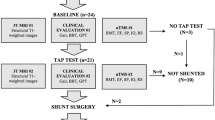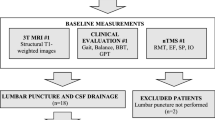Abstract
In 15 patients with symptomatic hydrocephalus, pressure-induced morphological changes of the brain and the function of callosal and corticospinal fibres were studied. Morphometry of the corpus callosum (CC) was performed on midsagittal MR images. Focal transcranial magnetic stimulation of the motor cortex was used to assess simultaneously excitatory motor responses in contralateral hand muscle (corticospinally mediated effect) and inhibition of tonic EMG activity in ipsilateral hand muscles (transcallosal inhibition (TI) of the contralateral motor cortex). Before a shunt operation, the midsagittal area of the CC was reduced by 34% on average. The height and, to a lesser degree the length, of the CC were increased before the shunt operation. Thresholds and central motor latencies of corticospinally mediated responses were normal, response amplitudes were smaller than in normal subjects. Motor thresholds increased from 38, SD 5 to 52, SD 8% (P<0.01) within 7 days after ventricular drainage, reflecting the increase in the distance between stimulation coil and brain. The threshold increase paralleled a restoration of normal anatomical conditions within 7 days after shunt operation and the improvement of motor symptoms and might be a predictor of successful decompression. Transcallosal inhibition could be elicited in all patients. The measurements of TI lay within the normal range except the duration, which was prolonged in 73% of 15 patients before shunt operation as a probable indicator of an increased dispersion of callosal conduction. The normalization of the area and shape of the CC after shunt operation and the normal corticospinal and callosal conduction times exclude degeneration, demyelination or functional block of a large proportion of callosal or corticospinal tract fibres or a substantial loss of nerve cells in motor cortex.
Similar content being viewed by others
Author information
Authors and Affiliations
Additional information
Received: 22 October 1997 Received in revised form: 13 January 1998 Accepted: 17 January 1998
Rights and permissions
About this article
Cite this article
Röricht, S., Meyer, BU., Woiciechowsky, C. et al. Callosal and corticospinal tract function in patients with hydrocephalus: a morphometric and transcranial magnetic stimulation study. J Neurol 245, 280–288 (1998). https://doi.org/10.1007/s004150050219
Issue Date:
DOI: https://doi.org/10.1007/s004150050219




